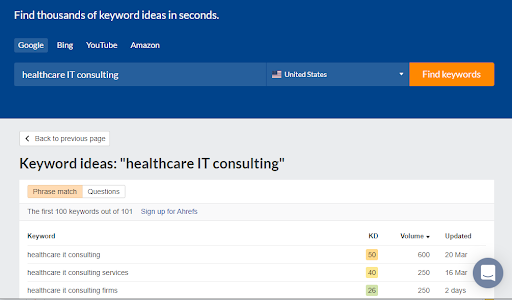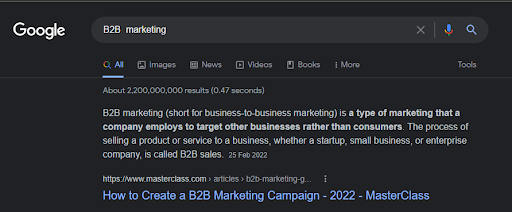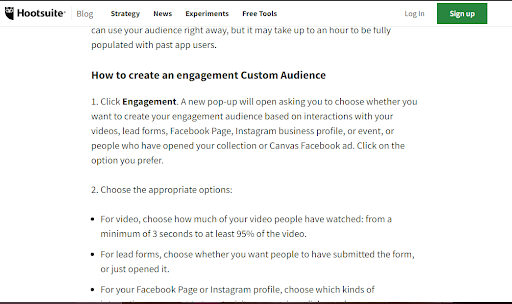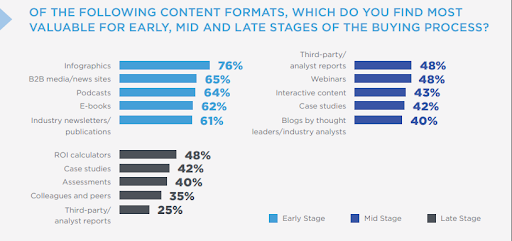Coming up with good content can be nerve-racking, but it doesn’t have to be. SEO copywriting helps you reach your target audience and rank higher in SERPs (Search Engine Result Pages). It might sound a little intimidating or complicated, but it’s easier than you think.
SEO optimizes the efficiency of content to rank higher than competing sites on Google search engines. Search engine crawlers prioritize content that serves users, so SEO copywriters only need to understand how Google works. Here are the 6 top SEO copywriting tips and some copywriting examples to help you rank higher in SERPs:
1. Select Relevant Keywords
The first step in SEO copywriting is identifying the relevant keywords before writing the content. You’ll need to target keywords while keeping the search intent in mind. Here’s an example:

(Source: Ahrefs)
There are plenty of tools to help you find relevant keywords within your niche and industry. Here’s a general guide on how to do content optimization:
- First, enter the primary search term, commonly known as the ‘seed’ keyword
- Set the SEO tool filters to organize your results by order of search volume, keyword difficulty, or any other important metrics
- View the chosen keywords’ intent to see whether they match up with your content goals
- Look at the word count, keywords, and the metatags on copywriting examples and ranking competing sites. Look through these keywords to help you broaden your ideas and see what you might be forgetting
Pro tip: Most SEO tools have a related keyword grouping column, which finds semantic keywords or questions related to your topic.
Insert the keywords into your blog posts, metatags, social media posts, and website copy to make it easier to find your content. These copywriting examples show individual keyword research is not enough to rank; copywriters need to create topical authority in their niche through pillar pages and supportive pages.
2. Optimize Your Content for Featured Snippets
Most people leave the SERP without even clicking on a single site because they get satisfactory results on featured snippets.
The featured snippet, a small content box that sometimes appears at the top of your SERP, gives a small amount of highly relevant information on the search. Here’s a picture of what this looks like:

(Source: Google)
For instance, when searching for a word, vital information is usually included in the featured snippet. Ensure that sentences that address the question are also included in your optimized content.
Here are a couple of ways to optimize content for a featured snippet:
- Answer questions concisely
- Use facts and organize your work well
- Ensure that your article answers similar questions
Some people might not click on it, but with good quality content optimization, at least your brand image is boosted.
3. Break up Your Content with Headlines
As a copywriter, always aim to break up your content using headlines, short paragraphs, bullets, and numbered lists. Other than the fact that people can’t easily absorb massive chunks of text all at once, this helps Google index to display your content on SERPs.
Header tags rank in order of their importance, from H1- H6, with H1 tags being the title. Header tags are not only used to break up content and improve readability, they’re also used to improve the SEO of the webpage by helping Google determine important sections.
Here’s a brief guide on how to use them:
- H1: As the title of the post. It’s usually SEO keyword-centric and crafted to shift the reader’s attention to the “big idea” of the post.
- H2: These subheaders classify the main points of your paragraphs while separating the post.
- H3: These subsections help clarify points made at H2. Alternatively, you can use them to format lists and bullet points.
- H4: These subsections help clarify H3. Alternatively, they can also be used to format lists or bullet points
Here’s one of the best copywriting examples from Hootsuite. This article has been shared more than 3,520 times now. It splits the article using headlines, short paragraphs, bullets, and numbered lists.

(Source: Hootsuite)
Most readers skim-read content and skip to the points they’re interested in. For this reason, always introduce your content with relevant headlines that help readers easily find what’s relevant to them.
4. Write Eye-catching Headlines
If the headline stinks, nobody will click through your website. Always set aside a substantial amount of time to brainstorm catchy headlines. Whenever you can, establish authority over the subject matter in your content.This is one of the best copywriting examples by Security Intelligence, that’s been shared 3,205 times as of today.

(Source: Security Intelligence)
This headline does not try to sell to the reader but draws them towards reading the rest of the article. The article uses correct grammar and doesn’t try to squeeze in too much. Instead, they focused on one key point, and the findings supported that point. As seen from this copywriting example, headlines with figures are a major winner. They usually get more shares on Twitter and Facebook as well.
Your headlines should:
- Be clear and precise
- Highlight the ‘benefit’ of reading the article
- Resonate with the reader
- Offer unique solutions
- Provide a sense of urgency
A high CTR gives you a better organic ranking on Google, which also gives you a greater volume of clicks. Headline copywriting is a powerful tool.
From the 50/50 rule of headlines, you should always spend half of the entire time it takes to write content on your headline. Additionally, the 80/20 rule of headlines suggests that most people only read the headline, and a tiny number reads the article after.
Studies, such as the F-shaped pattern study, show that the headline size is essential. The more eye-catching the headline, the higher the chances people will read.
5. Look At Search Intent
Creating a converting copy requires that you research the user and content intent, which varies depending on the user’s stage in their customer journey. Getting the ‘keyword intent’ means identifying why the user is typing in a specific search term.
These statistics on Demand Gen’s report show how vital the relevant content is in the buyer’s journey. B2B companies can use this to help them develop relevant content formats.

(Source: Demand Gen Report)
This information helps you target SEO keyword terms that match the commercial search intent of your user. There are four broad types of keyword intent; these include:
- Informational – where the user wants to learn more about a topic, product, or industry
- Navigational – where the user has an idea of what they want and is looking for a specific result, web page, or website
- Commercial – where the user is looking for information for purchase in the future
- Transactional – where the user has the intent to buy a product or service
Here’s how to determine the search intent:
- Knowing or filtering the keyword modifiers using the SERP feature on keyword research tools
- Read the SERP to help you determine what’s the most relevant search intent
- Consider more than the keywords and SERP, especially since SERPs are volatile, keyword rank for one intent now, then change next month
It’s in Google’s best interest to give its users top-notch search results, so it highly ranks marketers who closely match the keyword intent of the searcher.
6. Optimize the Header, Meta Title, and Description
The first thing your reader sees from what Google SERPs bring is the page’s meta title and its description. Once they’re on your page, the header is the first thing they’ll see. So always keep your meta and headlines interesting and clear to boost click-through rates. This helps Google to rank you and increase the views to your page.
Here are some guidelines to help copywriters best optimize their meta titles, meta description, and header:
- Meta titles: Be memorable and include the target keyword. Have 55-60 characters since Google usually shortens title tags that are more than 55-60 characters long
- Meta description: It should contain the target keywords that evoke emotion and include calls to action. Keep it brief since Google will shorten it to 155-160 characters for optimum user experience. Google encourages the inclusion of information such as the price and manufacturer
- H1 header: Fit it within a 600-pixel width so that readers can see the full title. Otherwise, Google will shorten it. Where relevant, include numbers and bracketed clarifications like [Buying Guide], etc. to give readers a complete picture of what they get once they click
The meta description and title tag should help both the search engines and users quickly determine what your content is all about.
Wrapping Up
Algorithms change, new information sprouts, and the internet evolves, so you need to update your content to help increase your content shelf-life. After publishing the content, check to confirm that Google understands your content correctly on the Google Search Console account.
You can also check what keywords your content is earning impressions for; if relevant to the original keyword goal, great, if not, you’ll need to revise it. You’re bound to rank higher in SERP with these content optimization tips. Good luck!


